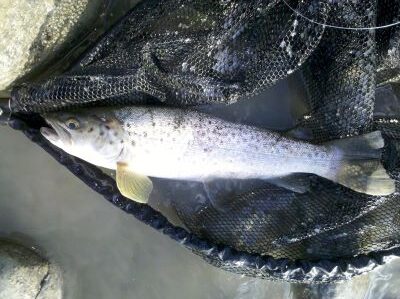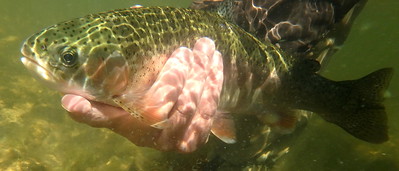They say that the best fishermen are the ones who can tell the biggest fish tales. But what about the ones who actually care about the fish they catch?
As much as we would love to keep all trout in the water, we know that’s not always possible. Most fishermen just can’t resist taking a photo with their catch or bringing it up onto the bank for an easier release.
That’s where education comes in. By learning the most humane ways to catch, control, and release these prized fish, we can all do our part to ensure they swim away safely.
Now, I’ll be the first to admit that I’ve made my fair share of mistakes. I have kept a trout out of the water too long or used a little too much force to remove a stubborn hook. But I’ve learned from those errors and I’m constantly striving to improve my methods.
Trout are truly magnificent creatures, and as fishermen, we should all respect and admire them. So, let’s work together to keep them swimming strong. And hey, if you catch a big one, feel free to exaggerate the size – just make sure to release it safely afterwards!
Avoid touching or damaging the Gills.
Never put your fingers in or anywhere near the gills of a trout.
To avoid harming the trout, it’s crucial to be mindful of their gills. These delicate organs are filled with blood vessels and even minor damage can be fatal. It’s best to never touch or put your fingers near a trout’s gills.
In warm water temperatures above 20°C (68°F), any injury to the gills can spell disaster for the fish. If a hook is lodged in a trout’s gills, it’s recommended to keep the fish rather than trying to remove the hook.
However, if you do release the fish, cut the line or hook and leave it in place. Attempting to remove the hook from the gills almost always results in the fish’s demise, whereas leaving it in gives the trout a chance to survive.
Keep trout in the water as much as possible.
Trout love water, how we love air. A trout out of water suffocates how a person under water drowns. We must keep trout in the water as much as possible. Trout breathe through their gills, for them to survive they must have water flowing through them.
Before handling a trout, WET your hands. This helps protect the slimly mucus membrane which protects the trout’s skin. Without it they can suffer from fungal and other infections. Never handle a trout with dry hands and avoid tailing gloves.
Wither sun gloves damage trout is a topic of much controversy, at the minimum wet them before handling trout. But it is probably a good idea to remove them.
Rubber gloves, like the ones worn in the winter for warmth, are much gentler on the trout’s protective slime. Like all gloves, they should be wet before handling trout you plan on releasing.
Trout do not belong on the shore.
To ensure the safety of the trout, it’s essential to keep them in the water as much as possible. Avoid placing the freshly caught trout on the shore or any dry surface, including sand, rocks, and vegetation. Such surfaces can strip off the trout’s protective slime, leaving them susceptible to bacterial infections and other harmful agents.
Furthermore, trout are not designed for life on land, and flapping around on hot gravel or any other dry surface can cause serious damage to their delicate skin. So, it’s crucial to keep them in the water to prevent any such harm.
To handle a trout, use a net to lift them out of the water and keep them there until you’re ready to release them. This method allows you to examine and unhook the trout without causing harm and keeps the fish safe and healthy for their return to the water. Remember, the ultimate goal is to release the trout back into their natural habitat as quickly and safely as possible.
Barbless hooks save trout.
One simple modification that can make a big difference in catch and release fishing is using barbless hooks or pinching down the barb of existing hooks.
Not only does this technique speed up the release process, but it also minimizes the damage caused by the hook.
It’s a universal approach that applies to hooks of all sizes and styles. So, no matter the level of experience, from the grizzly seasoned angler or just starting out, going barbless is the way to go when it comes to responsible catch and release fishing.
Trout are not your squeeze tool, minimize handling.
It should go without saying, minimize touching and handling any trout you plan on releasing. Do not take it out of the water for extended photo sessions. Do not carry it up to the campsite to show your kids prior to release.
When handling trout, be gentle. Do not squeeze them, do not stab fingers into their guts. Most definitely do not give them a whack to stun them and stop the wiggling prior to release.
Rather than holding a trout tightly, use your hands just to support and guide it. There is no need to squeeze its last meal out.
Holding trout upside can calm them.
If your trout is still a bit feisty and full energy. One trick is to try and hold the trout upside down. In that position they become so passive and much less likely to damage themselves thrashing about. With the trout feeling calmer, it is much easier to remove the hook.
Photograph trout quickly
When photographing trout, do it quickly and keep them wet. If you must lift it out of the water, make sure your hands are wet and have the camera ready.
Lift the trout out of the water, pose, then return the trout to the river. It should not be out of the water for more than five seconds.
For more details on how to photograph trout to minimize stress, check my guide here.

Use the correct tools to speed up the release.
There are many tools and accessories which can greatly speed up the time it takes to release a trout. The two most basic, and essential for all serious fishermen are a rubberized net and some forceps.
Rubberised nets are great, wide mouth ones are even better. Not only do nets allow you to catch and land fish much faster. The rubberized design is smooth, and the lack of knots protects the trout’s slimy membrane as much as possible. As added bonus, hooks are significantly less likely to tangle. While far from essential, nets with built in scales is the kindest and quickest way to weigh a fish.
Forceps, or a simple pair of pliers, make removing hooks much faster. I like long nose ones in case I have to reach deep into the trout’s mouth to remove a hook. Other useful features found on some pliers is a set of wire cutters. They make it possible to cut through a hook shank.
There are many other hook removal tools on the market I have used most over the years. They all work sometimes. But, the majority of the time, forceps are simply faster. This is a case of the simplest solution being the best one.
Do not prolong the fight
Try to fight and land the trout as quickly as possible. The longer the fight goes on the more stress and exhausted the trout will become. No matter how much fun, do not unnecessarily prolong a fight. This just tires the fish out and slows down its recovery.
Part of ending a fight quickly is by using as heavy a line and tackle you can get away with.
Revive and Release
With the hook removed, and photos taken, it is time to release the trout. Hopefully, the trout will be full of energy, and will dart away the moment it is free.
Gently place the trout into the water, with its head facing into the current. This allows the oxygen rich water to flow through its gill reviving it. Do not move the trout back and forth through the water, this does more harm than good.
Gently stabilize the fish, until you feel it kick. Then release and watch him swim away. Sometimes trout, rest for a while nearby before darting away.
Also take one second to make sure there are no opportunistic predators lurking in the shallows. It will be a bad feeling to release your trout only for it to become the meal of a shag or bass lurking nearby.

